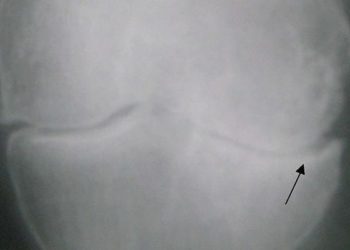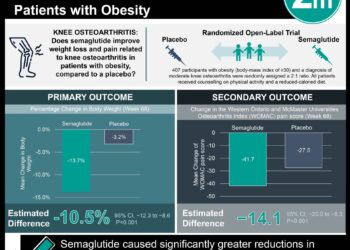Medial opening wedge high tibial osteotomy associated with improved outcomes in knee osteoarthritis with varus alignment
1. In this randomized trial, patients with medial compartment knee osteoarthritis who received medial opening wedge high tibial osteotomy had a smaller decrease in medial tibiofemoral articular cartilage thickness than those who received nonsurgical management alone.
2. Patients who underwent osteotomy also had greater improvement in functional outcomes.
Evidence Rating Level: 1 (Excellent)
Study Rundown: Medial opening wedge high tibial osteotomy (HTO) is a surgical intervention that aims to halt or slow the process of osteoarthritis by shifting ambulatory loads on the knee and reducing joint damage in the tibiofemoral compartment. It is often recommended for patients who are too young or whose disease is not severe enough for arthroplasty. Although HTO has been linked to long-term improvements in pain and disability, little is known about its effect on objective disease progression. This study aimed to assess the efficacy of HTO by comparing nonsurgical management plus HTO versus nonsurgical management alone among patients with varus alignment and medial compartment knee osteoarthritis. Among 56 randomized participants, those who underwent HTO lost less significantly less medial tibiofemoral articular cartilage thickness over a two-year period compared to those who received nonsurgical management alone. The HTO group also had significantly greater outcome scores at two years of follow-up. There were more adverse events reported in the HTO group, including those requiring treatment with antibiotics, physical rehabilitation, or repeat surgery. Conversely, no adverse events requiring treatment occurred in the nonsurgical group. Similar results were reported among an approximately equally sized sample of participants who showed a preference for a particular treatment. The generalizability of this study was limited by its single-center design, small sample size, and unequal sex ratio. Nevertheless, these results suggested that medial opening HTO can be effective in reducing structural joint damage and improving clinical outcomes in medial knee osteoarthritis with varus alignment.
Click to read this study in AIM
Relevant Reading: Medial opening wedge high tibial osteotomy for the treatment of medial unicompartmental knee osteoarthritis: A state-of-the-art review
In-Depth [randomized controlled trial]: This randomized trial with parallel preference arm aimed to assess the efficacy of nonsurgical management plus HTO versus nonsurgical management alone among patients with varus alignment and medial compartment knee osteoarthritis. Participants were eligible if they had knee osteoarthritis and varus alignment of the lower limb with radiographic joint damage primarily affecting the medial tibiofemoral compartment. Patients were excluded if they had end-stage disease, had previous HTO or arthroplasty, or inflammatory or infectious arthritis. Patients were either randomized to the HTO or control group or, if they preferred a particular treatment, invited to enroll in a preference arm. The primary outcome was change in cartilage thickness in the medial tibiofemoral compartment from baseline to 2 years of follow-up as measured on MRI. Secondary outcomes included Knee Injury and Osteoarthritis Outcome Score (KOOS); gait; the 6-minute walk test; and the 40-meter fast-paced walk test. The randomized arm included 71 participants, including 35 in the HTO group and 36 in the control group; HTO participants had a median age of 55 years (standard deviation [SD], 6) years and was 25.7% (n = 9) female, while control participants had a median age of 54 (SD, 7) years and was 22.2% (n = 8) female. Primary analysis included baseline and follow-up MRI data for 56 participants (28 HTO, 28 control). The HTO group reported a mean 2-year change in medial tibiofemoral articular cartilage thickness of -0.07 mm (95% CI, -0.15 to 0.01 mm), corresponding to a loss of 2% from baseline. The control group reported a mean 2-year change in medial tibiofemoral articular cartilage thickness of -0.25 mm (95% CI, -0.33 to -0.17 mm), corresponding to a loss of 9% from baseline. The mean difference between groups was 0.18 mm (95% CI, 0.18 to 0.19 mm). The mean 2-year improvement in total KOOS was 24.95 points in the HTO group and 9.06 points in the control group, yielding a difference of 15.89 points (95% CI, 8.94 to 22.84 points). Changes in the 6-minute walk test and 40-meter fast-paced shuttle did not consistently favor HTO. Among the HTO group, 13% of participants (4 of 32) had an adverse event that did not require additional treatment, 6% (2 of 32) had incision redness or superficial cellulitis treated with oral antibiotics, 13% (4 of 32) had an adverse event treated with postoperative rehabilitation, and 9% (3 of 32) had an adverse event treated with additional surgery. Among the control group, 21% of participants (7 of 34) had an adverse event in the index limb, none of whom needed additional treatment. Overall, this study suggested that HTO may be an effective treatment modality for reducing structural joint damage among patients with varus alignment and medial compartment knee osteoarthritis.
Image: PD
©2025 2 Minute Medicine, Inc. All rights reserved. No works may be reproduced without expressed written consent from 2 Minute Medicine, Inc. Inquire about licensing here. No article should be construed as medical advice and is not intended as such by the authors or by 2 Minute Medicine, Inc.







